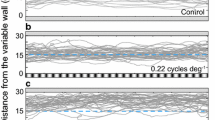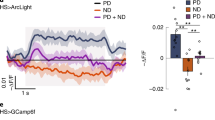Abstract
We propose a new bio-plausible model based on the visual systems of Drosophila for estimating angular velocity of image motion in insects’ eyes. The model implements both preferred direction motion enhancement and non-preferred direction motion suppression which is discovered in Drosophila’s visual neural circuits recently to give a stronger directional selectivity. In addition, the angular velocity detecting model (AVDM) produces a response largely independent of the spatial frequency in grating experiments which enables insects to estimate the flight speed in cluttered environments. This also coincides with the behaviour experiments of honeybee flying through tunnels with stripes of different spatial frequencies.
Access this chapter
Tax calculation will be finalised at checkout
Purchases are for personal use only
Similar content being viewed by others
References
Fischbach, K.F.: Dittrich APM: the optic lobe of drosopholia melanogaster. I. A Golgi analysis of wild-type structure. Cell Tissue Res. 258(3), 441–475 (1989). https://doi.org/10.1007/BF00218858
Joesch, M., Weber, F., Raghu, S.V., Reiff, D.F., Borst, A.: ON and OFF pathways in Drosophila motion vision. Nature 17(1), 300–304 (2011). https://doi.org/10.1038/nature09545
Takemura, S.Y., Nern, A., Chklovskii, D.B., Scheffer, L.K., Rubin, G.M., Meinertzhagen, I.A.: The comprehensive connectome of a neural substrate for ‘ON’ motion detection in Drosophila. eLife 6, e24394 (2017). https://doi.org/10.7554/eLife.24394
Arenz, A., Drews, M.S., Richter, F.G., Ammer, G., Borst, A.: The temporal tuning of the Drosophila motion detectors is determined by the dynamics of their input elements. Curr. Biol. 27, 929–944 (2017). https://doi.org/10.1016/j.cub.2017.01.051
Haag, J., Mishra, A., Borst, A.: A common directional tuning mechanism of Drosophila motion-sensing neurons in the ON and in the OFF pathway. eLife 6, e29044 (2017). https://doi.org/10.7554/eLife.29044
Hassenstein, B., Reichardt, W.: Systemtheoretische analyse der zeit-, reihenfolgen- und vorzeichenauswertung bei der bewegungsperzeption des rüsselkäfers chlorophanus. Zeitschrift Für Naturforschung B 11(9–10), 513–524 (1956). https://doi.org/10.1515/znb-1956-9-1004
Barlow, H.B., Levick, W.R.: The mechanism of directionally selective units in rabbit’s retina. J. Physiol. 178, 477–504 (1965). https://doi.org/10.1113/jphysiol.1965.sp007638
Behnia, R., Clark, D.A., Carter, A.G., Clandinin, T.R., Desplan, C.: Processing properties of ON and OFF pathways for Drosophila motion detection. Nature 512, 427–430 (2014). https://doi.org/10.1038/nature13427
Haag, J., Arenz, A., Serbe, E., Gabbiani, F., Borst, A.: Complementary mechanisms create direction selectivity in the fly. eLife 5, e17421 (2016). https://doi.org/10.7554/eLife.17421
Ibbotson, M.R.: Evidence for velocity-tuned motion-sensitive descending neurons in the honeybee. Proc. Biol. Sci. 268(1482), 2195 (2001). https://doi.org/10.1098/rspb.2001.1770
Srinivasan, M.V., Lehrer, M., Kirchner, W.H., Zhang, S.W.: Range perception through apparent image speed in freely flying honeybees. Vis. Neurosci. 6(5), 519–535 (1991). https://www.ncbi.nlm.nih.gov/pubmed/2069903
Riabinina, O., Philippides, A.O.: A model of visual detection of angular speed for bees. J. Theor. Biol. 257(1), 61–72 (2009). https://doi.org/10.1016/j.jtbi.2008.11.002
Cope, A., Sabo, C., Gurney, K.N., Vasislaki, E., Marshall, J.A.R.: A model for an angular velocity-tuned motion detector accounting for deviations in the corridor-centering response of the Bee. PLoS Comput Biol. 12(5), e1004887 (2016). https://doi.org/10.1371/journal.pcbi.1004887
Ibbotson, M.R., Hung, Y.S., Meffin, H., Boeddeker, N., Srinivasan, M.V.: Neural basis of forward flight control and landing in honeybees. Sci. Rep. 7(1), 14591 (2017). https://doi.org/10.1038/s41598-017-14954-0
Dyhr, J.P., Higgins, C.M.: The spatial frequency tuning of optic-flow-dependent behaviors in the bumblebee Bombus impatiens. J. Exp. Biol. 213(Pt 10), 1643–50 (2010). https://doi.org/10.1242/jeb.041426
Baird, E., Srinivasan, M.V., Zhang, S., Cowling, A.: Visual control of flight speed in honeybees. J. Exp. Biol. 208(20), 3895–905 (2005). https://doi.org/10.1242/jeb.01818
Acknowledgments
This research is supported by EU FP7-IRSES Project LIVCODE (295151), HAZCEPT (318907) and HORIZON project STEP2DYNA (691154).
Author information
Authors and Affiliations
Corresponding author
Editor information
Editors and Affiliations
Rights and permissions
Copyright information
© 2018 Springer Nature Switzerland AG
About this paper
Cite this paper
Wang, H., Peng, J., Baxter, P., Zhang, C., Wang, Z., Yue, S. (2018). A Model for Detection of Angular Velocity of Image Motion Based on the Temporal Tuning of the Drosophila. In: Kůrková, V., Manolopoulos, Y., Hammer, B., Iliadis, L., Maglogiannis, I. (eds) Artificial Neural Networks and Machine Learning – ICANN 2018. ICANN 2018. Lecture Notes in Computer Science(), vol 11140. Springer, Cham. https://doi.org/10.1007/978-3-030-01421-6_4
Download citation
DOI: https://doi.org/10.1007/978-3-030-01421-6_4
Published:
Publisher Name: Springer, Cham
Print ISBN: 978-3-030-01420-9
Online ISBN: 978-3-030-01421-6
eBook Packages: Computer ScienceComputer Science (R0)




